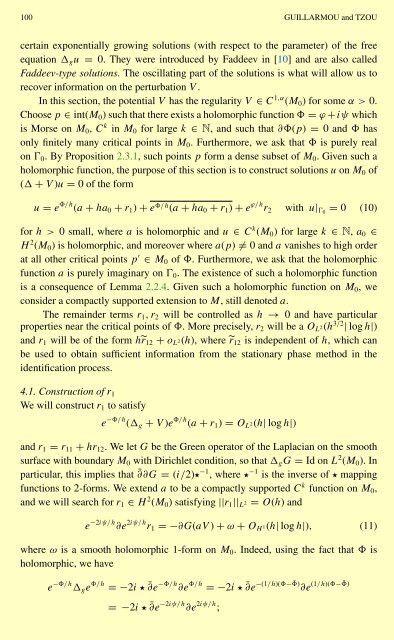NEAR OPTIMAL BOUNDS IN FREIMAN'S THEOREM
NEAR OPTIMAL BOUNDS IN FREIMAN'S THEOREM
NEAR OPTIMAL BOUNDS IN FREIMAN'S THEOREM
You also want an ePaper? Increase the reach of your titles
YUMPU automatically turns print PDFs into web optimized ePapers that Google loves.
100 GUILLARMOU and TZOU<br />
certain exponentially growing solutions (with respect to the parameter) of the free<br />
equation gu = 0. They were introduced by Faddeev in [10] and are also called<br />
Faddeev-type solutions. The oscillating part of the solutions is what will allow us to<br />
recover information on the perturbation V .<br />
In this section, the potential V has the regularity V ∈ C 1,α (M0) for some α>0.<br />
Choose p ∈ int(M0) such that there exists a holomorphic function = ϕ +iψ which<br />
is Morse on M0, C k in M0 for large k ∈ N, and such that ∂(p) = 0 and has<br />
only finitely many critical points in M0. Furthermore, we ask that is purely real<br />
on Ɣ0. By Proposition 2.3.1, such points p form a dense subset of M0. Given such a<br />
holomorphic function, the purpose of this section is to construct solutions u on M0 of<br />
( + V )u = 0 of the form<br />
u = e /h (a + ha0 + r1) + e /h (a + ha0 + r1) + e ϕ/h r2 with u|Ɣ0 = 0 (10)<br />
for h>0 small, where a is holomorphic and u ∈ C k (M0) for large k ∈ N, a0 ∈<br />
H 2 (M0) is holomorphic, and moreover where a(p) = 0 and a vanishes to high order<br />
at all other critical points p ′ ∈ M0 of . Furthermore, we ask that the holomorphic<br />
function a is purely imaginary on Ɣ0. The existence of such a holomorphic function<br />
is a consequence of Lemma 2.2.4. Given such a holomorphic function on M0, we<br />
consider a compactly supported extension to M, still denoted a.<br />
The remainder terms r1,r2 will be controlled as h → 0 and have particular<br />
properties near the critical points of . More precisely, r2 will be a OL 2(h3/2 | log h|)<br />
and r1 will be of the form hr12 + oL 2(h), where r12 is independent of h, which can<br />
be used to obtain sufficient information from the stationary phase method in the<br />
identification process.<br />
4.1. Construction of r1<br />
We will construct r1 to satisfy<br />
e −/h (g + V )e /h (a + r1) = OL2(h| log h|)<br />
and r1 = r11 + hr12. WeletGbe the Green operator of the Laplacian on the smooth<br />
surface with boundary M0 with Dirichlet condition, so that gG = Id on L2 (M0).In<br />
particular, this implies that ¯∂∂G = (i/2)⋆−1 , where ⋆−1 is the inverse of ⋆ mapping<br />
functions to 2-forms. We extend a to be a compactly supported Ck function on M0,<br />
and we will search for r1 ∈ H 2 (M0) satisfying ||r1||L2 = O(h) and<br />
e −2iψ/h ∂e 2iψ/h r1 =−∂G(aV ) + ω + OH 1(h| log h|), (11)<br />
where ω is a smooth holomorphic 1-form on M0. Indeed, using the fact that is<br />
holomorphic, we have<br />
e −/h ge /h =−2i ⋆¯∂e −/h ∂e /h =−2i ⋆¯∂e −(1/h)(− ¯) ∂e (1/h)(− ¯)<br />
=−2i ⋆¯∂e −2iψ/h ∂e 2iψ/h ;

















